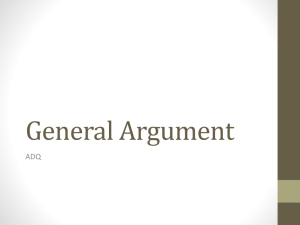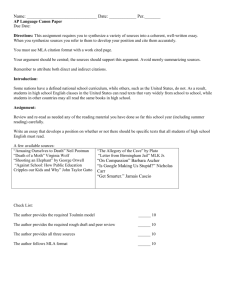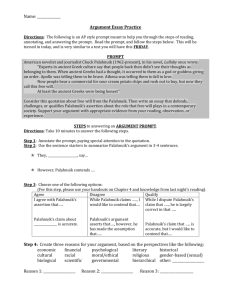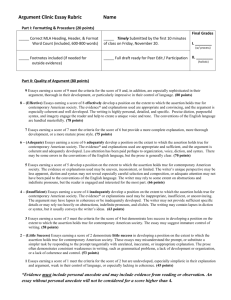AP and Pre-AP Deconstruction of an Argument: Timed Writing Rubric
advertisement
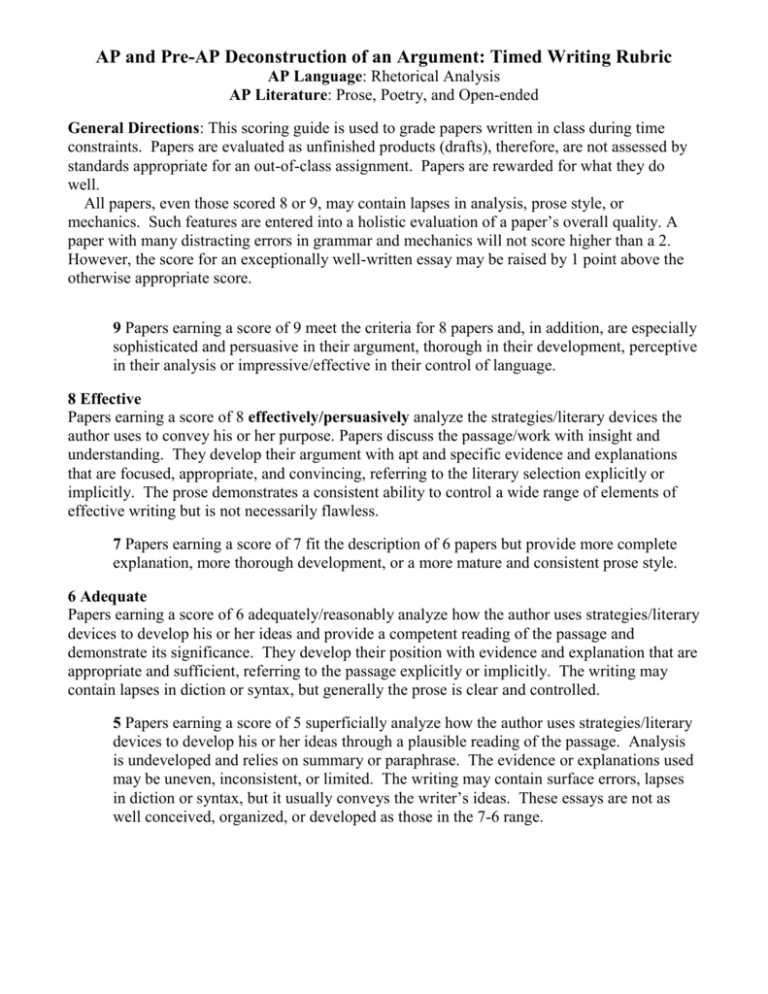
AP and Pre-AP Deconstruction of an Argument: Timed Writing Rubric AP Language: Rhetorical Analysis AP Literature: Prose, Poetry, and Open-ended General Directions: This scoring guide is used to grade papers written in class during time constraints. Papers are evaluated as unfinished products (drafts), therefore, are not assessed by standards appropriate for an out-of-class assignment. Papers are rewarded for what they do well. All papers, even those scored 8 or 9, may contain lapses in analysis, prose style, or mechanics. Such features are entered into a holistic evaluation of a paper’s overall quality. A paper with many distracting errors in grammar and mechanics will not score higher than a 2. However, the score for an exceptionally well-written essay may be raised by 1 point above the otherwise appropriate score. 9 Papers earning a score of 9 meet the criteria for 8 papers and, in addition, are especially sophisticated and persuasive in their argument, thorough in their development, perceptive in their analysis or impressive/effective in their control of language. 8 Effective Papers earning a score of 8 effectively/persuasively analyze the strategies/literary devices the author uses to convey his or her purpose. Papers discuss the passage/work with insight and understanding. They develop their argument with apt and specific evidence and explanations that are focused, appropriate, and convincing, referring to the literary selection explicitly or implicitly. The prose demonstrates a consistent ability to control a wide range of elements of effective writing but is not necessarily flawless. 7 Papers earning a score of 7 fit the description of 6 papers but provide more complete explanation, more thorough development, or a more mature and consistent prose style. 6 Adequate Papers earning a score of 6 adequately/reasonably analyze how the author uses strategies/literary devices to develop his or her ideas and provide a competent reading of the passage and demonstrate its significance. They develop their position with evidence and explanation that are appropriate and sufficient, referring to the passage explicitly or implicitly. The writing may contain lapses in diction or syntax, but generally the prose is clear and controlled. 5 Papers earning a score of 5 superficially analyze how the author uses strategies/literary devices to develop his or her ideas through a plausible reading of the passage. Analysis is undeveloped and relies on summary or paraphrase. The evidence or explanations used may be uneven, inconsistent, or limited. The writing may contain surface errors, lapses in diction or syntax, but it usually conveys the writer’s ideas. These essays are not as well conceived, organized, or developed as those in the 7-6 range. 4 Inadequate Papers earning a score of 4 inadequately analyze how the author uses strategies to develop his or her ideas. These papers may misunderstand the literary selection, misrepresent or ignore the strategies/literary devices the author uses, or may analyze these strategies inaccurately. The evidence or explanations used may be inappropriate, insufficient, irrelevant, partial, unfocused, repetitive, or less convincing. The prose generally conveys the writer’s ideas but may contain an accumulation of errors and is less consistent in controlling the elements of effective writing. 3 Papers earning a score of 3 meet the criteria for a score of 4 but demonstrate less success in analyzing the author’s use of strategies to communicate his or her purpose. They are less perceptive in the understanding of a literary selection or strategies, or the explanation or examples may be particularly limited or simplistic. The papers may show incompetence and less maturity in control of writing. 2 Little Success Papers earning a score of 2 demonstrate little success in analyzing how the author uses strategies to communicate his or her purpose and are unacceptably brief. These papers may misunderstand the prompt, misread the passage, fail to analyze the strategies the author uses, or substitute a simpler task by responding to the prompt tangentially with unrelated, inaccurate, or inappropriate explanation. Ideas are presented with little clarity, organization, or support from the passage. The prose often demonstrates consistent weakness in writing, such as grammatical problems, a lack of development or organization, or a lack of control. 1 Papers earning a score of 1 meet the criteria for a score of 2 but are undeveloped, especially simplistic in their explanation, incompetent, incoherent, or weak in their control of language. 0 Indicates an on-topic response that receives no credit, such as one that merely repeats or references the prompt or shifts or responds in a language other than English. Ø B Indicates a blank response or one that is completely off topic. Attention: For the purposes of scoring, analysis (deconstruction) refers to identifying features of a text and explaining how the author uses these to develop the meaning or to achieve a particular effect or purpose. Grading Scale 9 = 100 8 = 95 7 = 90 6 = 85 5 = 75 4 = 70 3 = 65 2 = 60 1 = 50 0/ Ø B = 0 AP and Pre-AP Construction of an Argument: Timed Writing Rubric AP Language: Argument, Synthesis General Directions: This scoring guide is used to grade papers written in class during time constraints. Papers are evaluated as unfinished products (drafts), therefore, are not assessed by standards appropriate for an out-of-class assignment. Papers are rewarded for what they do well. All papers, even those scored 8 or 9, may contain lapses in analysis, prose style, or mechanics. Such features are entered into a holistic evaluation of a paper’s overall quality. A paper with many distracting errors in grammar and mechanics will not score higher than a 2. 9 Papers earning a score of 9 meet the criteria for 8 papers and, in addition, are especially sophisticated in their argument, thorough in their development, or impressive in their control of language. 8 Effective Papers earning a score of 8 effectively assert an argument in response to the prompt. They develop their argument with evidence and explanations that are appropriate and convincing, and the argument is especially coherent and well developed. The prose demonstrates a consistent ability to control a wide range of elements of effective writing but is not necessarily flawless. 7 Papers earning a score of 7 fit the description of 6 papers but provide more complete explanation, more thorough development, or a more mature prose style. 6 Adequate Papers earning a score of 6 adequately assert an argument in response to the prompt. They develop their position with evidence and explanation that are appropriate and sufficient, referring to the passage explicitly or implicitly. The writing may contain lapses in diction or syntax, but generally the prose is clear. 5 Papers earning a score of 5 assert an argument in response to the prompt. The evidence or explanations used may be uneven, inconsistent, or limited. The writing may contain lapses in diction or syntax, but it usually conveys the writer’s ideas. 4 Inadequate Papers earning a score of 4 inadequately assert an argument in response to the prompt. The evidence or explanations used may be inappropriate, insufficient, or less convincing. The prose generally conveys the writer’s ideas but may be less consistent in controlling the elements of effective writing. 3 Papers earning a score of 3 meet the criteria for a score of 4 but demonstrate less success in asserting an argument in response to the prompt. The papers may show less maturity in control of writing. 2 Little Success Papers earning a score of 2 demonstrate little success in asserting an argument in response to the prompt. These papers may misunderstand the prompt, or substitute a simpler task by responding to the prompt tangentially with unrelated, inaccurate, or inappropriate explanation. The prose often demonstrates consistent weakness in writing, such as grammatical problems, a lack of development or organization, or a lack of coherence and control. 1 Papers earning a score of 1 meet the criteria for a score of 2 but are undeveloped, especially simplistic in their explanation and argument, or weak in their control of language, or especially lacking in coherence and development. 0 Indicates an on-topic response that receives no credit, such as one that merely repeats the prompt or shifts or responds in a language other than English. Ø B Indicates a blank response or one that is completely off topic Attention: In the AP Language Documented Argument, students must synthesize 3 or more sources in order to score a 5 or above. In no case will a Documented Argument that synthesizes fewer than 3 sources earn a score of 5 or above. Grading Scale 9 = 100 8 = 95 7 = 90 6 = 85 5 = 75 4 = 70 3 = 65 2 = 60 1 = 50 0/ Ø B = 0
